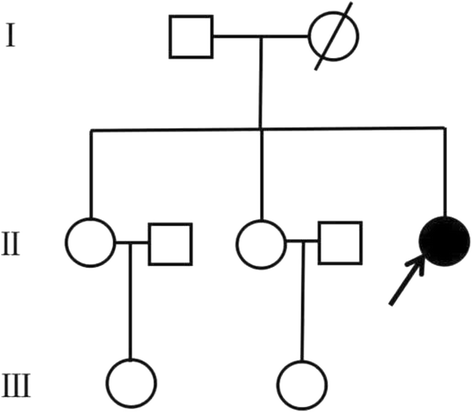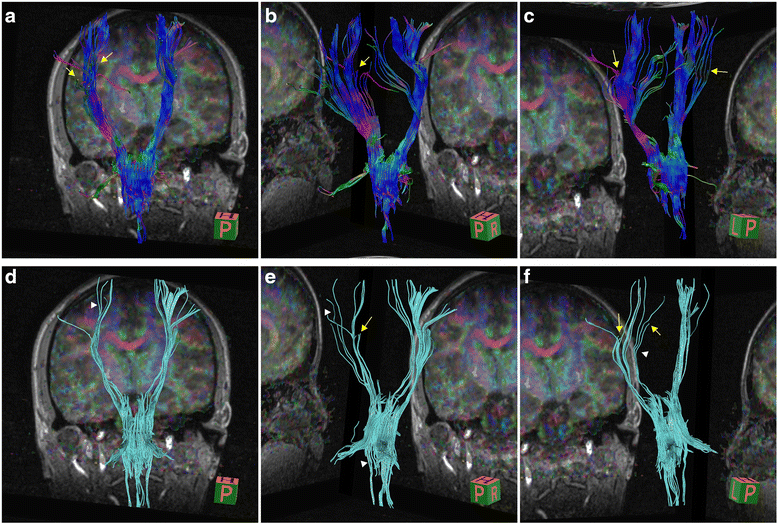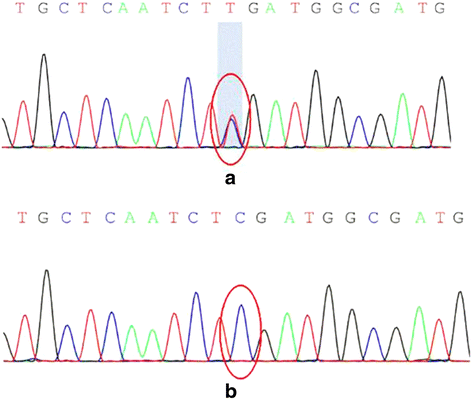A case of rapid-onset dystonia-parkinsonism accompanied by pyramidal tract impairment - PubMed (original) (raw)
Case Reports
A case of rapid-onset dystonia-parkinsonism accompanied by pyramidal tract impairment
Yanqiu Liu et al. BMC Neurol. 2016.
Abstract
Background: Rapid-onset dystonia-parkinsonism (RDP) is a rare autosomal dominant disorder that is caused by mutations in the ATP1A3 gene and is characterized by an acute onset of asymmetric dystonia and parkinsonism. To date, fewer than 75 RDP cases have been reported worldwide. Clinical signs of pyramidal tract involvement have been reported in several RDP cases, and none of them included the Babinski sign.
Case presentation: We report a 24-year-old Chinese female with RDP who exhibited a strikingly asymmetric, predominantly dystonic movement disorder with a rostrocaudal gradient of involvement and parkinsonism. Physical examiniations revealed hyperactive reflexes, bilateral ankle clonus and positive Babinski sign in the right. DTI showed reduced white matter integrity of the corticospinal tract in the frontal lobe and subpontine plane. Genetic testing revealed a missense mutation of the ATP1A3-gene (E277K) in the patient.
Conclusion: We suggest that pyramidal tract impairment could be involved in rapid-onset dystonia-parkinsonism and the pyramidal tract impairment in RDP needs to be differentiated from HSP.
Keywords: E277K mutation; Na+/K+ −ATPase α3 subunit gene (ATP1A3); Pyramidal tract impairment; Rapid-onset dystonia-parkinsonism (RDP).
Figures
Fig. 1
The pedgree for this patient. Squares indicate males; circles, females; arrow, proband; filled circle, affected female; circle with oblique line, died female
Fig. 2
Prominent lower lip concavity in our patient. Our patient presented prominent lower lip concavity, as shown in the picture
Fig. 3
Diffusion tensor imaging (DTI) of the patient. Diffusion tensor imaging (DTI) showed reduced white matter integrity of the corticospinal tract in the frontal lobe and subpontine plane. The left side of corticospinal tract showed more sparse in the frontal lobe and subpontine plane than the other side (filled triangles in white shown in picture d, e, f). Also, we could find some interruption in left side of corticospinal tract (arrows in yellow in picture a, b, c, e, f). In addition, we could still see some interruption in the right side of corticospinal tract (arrows in yellow in picture c)
Fig. 4
Next-generation sequencing of the patient and her father. Next-generation sequencing of the patient revealed a heterozygous nucleotide substitution (c.829G > A) in ATP1A3 gene in exon 8 of chromosome 19 (chr19:42489234) (a). Next-generation sequencing of the patient’s father revealed no nucleotide substitution in ATP1A3 gene (b)
Similar articles
- The Expanding Phenotypic Spectrums Associated with ATP1A3 Mutation in a Family with Rapid-Onset Dystonia Parkinsonism.
Yuan Y, Ran L, Lei L, Zhu H, Zhu X, Chen H. Yuan Y, et al. Neurodegener Dis. 2020;20(2-3):84-89. doi: 10.1159/000511733. Epub 2020 Dec 16. Neurodegener Dis. 2020. PMID: 33326973 - [A childhood-onset rapid-onset dystonia parkinsonism family with ATP1A3 gene mutation and literatures review].
Zhang CL, Yin F, He F, Gai N, Shi ZQ, Peng J. Zhang CL, et al. Zhonghua Er Ke Za Zhi. 2017 Apr 2;55(4):288-293. doi: 10.3760/cma.j.issn.0578-1310.2017.04.011. Zhonghua Er Ke Za Zhi. 2017. PMID: 28441826 Review. Chinese. - Mutations in the Na+/K+ -ATPase alpha3 gene ATP1A3 are associated with rapid-onset dystonia parkinsonism.
de Carvalho Aguiar P, Sweadner KJ, Penniston JT, Zaremba J, Liu L, Caton M, Linazasoro G, Borg M, Tijssen MA, Bressman SB, Dobyns WB, Brashear A, Ozelius LJ. de Carvalho Aguiar P, et al. Neuron. 2004 Jul 22;43(2):169-75. doi: 10.1016/j.neuron.2004.06.028. Neuron. 2004. PMID: 15260953 - Comparative analysis of alternating hemiplegia of childhood and rapid-onset dystonia-parkinsonism ATP1A3 mutations reveals functional deficits, which do not correlate with disease severity.
Lazarov E, Hillebrand M, Schröder S, Ternka K, Hofhuis J, Ohlenbusch A, Barrantes-Freer A, Pardo LA, Fruergaard MU, Nissen P, Brockmann K, Gärtner J, Rosewich H. Lazarov E, et al. Neurobiol Dis. 2020 Sep;143:105012. doi: 10.1016/j.nbd.2020.105012. Epub 2020 Jul 10. Neurobiol Dis. 2020. PMID: 32653672 - The expanding spectrum of neurological phenotypes in children with ATP1A3 mutations, Alternating Hemiplegia of Childhood, Rapid-onset Dystonia-Parkinsonism, CAPOS and beyond.
Sweney MT, Newcomb TM, Swoboda KJ. Sweney MT, et al. Pediatr Neurol. 2015 Jan;52(1):56-64. doi: 10.1016/j.pediatrneurol.2014.09.015. Epub 2014 Oct 13. Pediatr Neurol. 2015. PMID: 25447930 Free PMC article. Review.
Cited by
- Atypical presentation of rapid-onset dystonia-parkinsonism in a toddler with a novel mutation in the ATP1A3 gene.
Ganesh A, Sivakumar S, Manokaran R, Narasimhan U. Ganesh A, et al. BMJ Case Rep. 2021 Aug 19;14(8):e244152. doi: 10.1136/bcr-2021-244152. BMJ Case Rep. 2021. PMID: 34413044 Free PMC article. - The Structure and Function of the Na,K-ATPase Isoforms in Health and Disease.
Clausen MV, Hilbers F, Poulsen H. Clausen MV, et al. Front Physiol. 2017 Jun 6;8:371. doi: 10.3389/fphys.2017.00371. eCollection 2017. Front Physiol. 2017. PMID: 28634454 Free PMC article. Review. - ATP1A3 mutation in rapid-onset dystonia parkinsonism: New data and genotype-phenotype correlation analysis.
Yu L, Peng G, Yuan Y, Tang M, Liu P, Liu X, Ni J, Li Y, Ji C, Fan Z, Zhu W, Luo B, Ke Q. Yu L, et al. Front Aging Neurosci. 2022 Aug 1;14:933893. doi: 10.3389/fnagi.2022.933893. eCollection 2022. Front Aging Neurosci. 2022. PMID: 35978945 Free PMC article. - ATP1A3-Related Disorders: An Ever-Expanding Clinical Spectrum.
Salles PA, Mata IF, Brünger T, Lal D, Fernandez HH. Salles PA, et al. Front Neurol. 2021 Apr 1;12:637890. doi: 10.3389/fneur.2021.637890. eCollection 2021. Front Neurol. 2021. PMID: 33868146 Free PMC article. Review.
References
- Oblak AL, Hagen MC, Sweadner KJ, Haq I, Whitlow CT, Maldjian JA, et al. Rapid-onset dystonia-parkinsonism associated with the I758S mutation of the ATP1A3 gene: a neuropathologic and neuroanatomical study of four siblings. Acta Neuropathol. 2014;128:81–98. doi: 10.1007/s00401-014-1279-x. - DOI - PMC - PubMed
Publication types
MeSH terms
Substances
Supplementary concepts
LinkOut - more resources
Full Text Sources
Other Literature Sources
Research Materials



